Menu
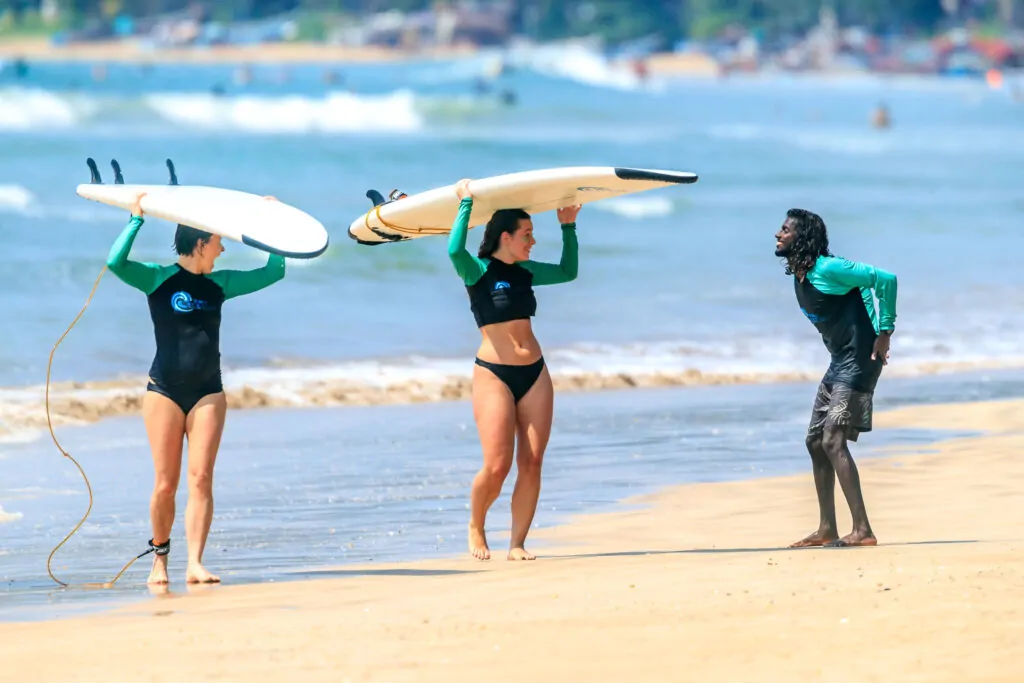
Sri Lanka, a tropical island nation nestled in the Indian Ocean, offers an enticing summer escape. While some assume summer brings monsoons, the island’s diverse climate means there’s always a sunny coast to enjoy. The eastern and northern regions truly shine during these months, boasting golden beaches perfect for sunbathing, swimming, and water sports.
How to Get to Arugam Bay: Your Ultimate Travel Guide
Planning your trip to the stunning shores of Arugam Bay? While this popular surfing destination on Sri Lanka’s east coast offers unparalleled beauty, it’s good to know your transportation options. Currently, there are two primary ways to reach Arugam Bay: by private vehicle or via public transport (bus). It’s important to note that Arugam Bay does not have a train station. Here’s a breakdown of how to reach Arugam Bay from various key locations in Sri Lanka using public buses:
From Colombo: If you’re starting your journey from Colombo, the capital city, you have a couple of straightforward bus routes:
Option 1 (Direct Bus Route): Take a direct bus from Colombo to Pottuvil. Once you arrive in Pottuvil, simply hop on a short local bus or a tuk-tuk to Arugam Bay.
Option 2 (Via Monaragala): Alternatively, you can catch a bus from Colombo to Monaragala. From Monaragala, you’ll then need to take another bus to Pottuvil, and then the final short ride to Arugam Bay.
From Kandy, Nuwara Eliya, or Ella (Central Highlands): For travelers coming from the Central Highlands your journey will typically involve a transfer in Wellawaya or Monaragala:
Option 1 (Via Wellawaya): Take a bus to Wellawaya. From Wellawaya, find a connecting bus that goes to Pottuvil-Arugam Bay.
Option 2 (Via Monaragala): Take a bus to Monaragala. From Monaragala, connect to a bus heading towards Pottuvil-Arugam Bay.
From Galle or Mirissa Catch a bus from Galle or Mirissa that’s headed towards Monaragala. Once you reach Monaragala, transfer to a bus that will take you to Pottuvil-Arugam Bay.
While the journey might involve a few transfers, traveling by bus is an authentic and economical way to experience Sri Lanka’s diverse landscapes on your way to Arugam Bay!
Arugam Bay nestled on the south-east coast of Sri Lanka, is renowned worldwide as a vibrant hub for incredible surfing. But even if riding the waves isn’t your calling, this charming town offers a wealth of experiences that make it a must-visit destination.
Beyond the thrilling breaks, Arugam Bay invites you to unwind and explore. Imagine leisurely strolls along pristine, spectacular beaches or finding your inner calm with a revitalizing yoga class. The natural beauty here is truly captivating. For wildlife enthusiasts, a short trip to Lahugala National Park promises a unique spectacle: majestic elephants grazing on the shores of the tank. And if you venture a little further afield to Kumana National Park, you might just strike gold. Keep your eyes peeled for elusive leopards sleeping on granite outcrops or a shaggy sloth bear feasting on the fallen red berries of a weera tree.
Whether you’re chasing the perfect wave or seeking a tranquil escape surrounded by nature and wildlife, Arugam Bay offers an unforgettable Sri Lankan adventure.
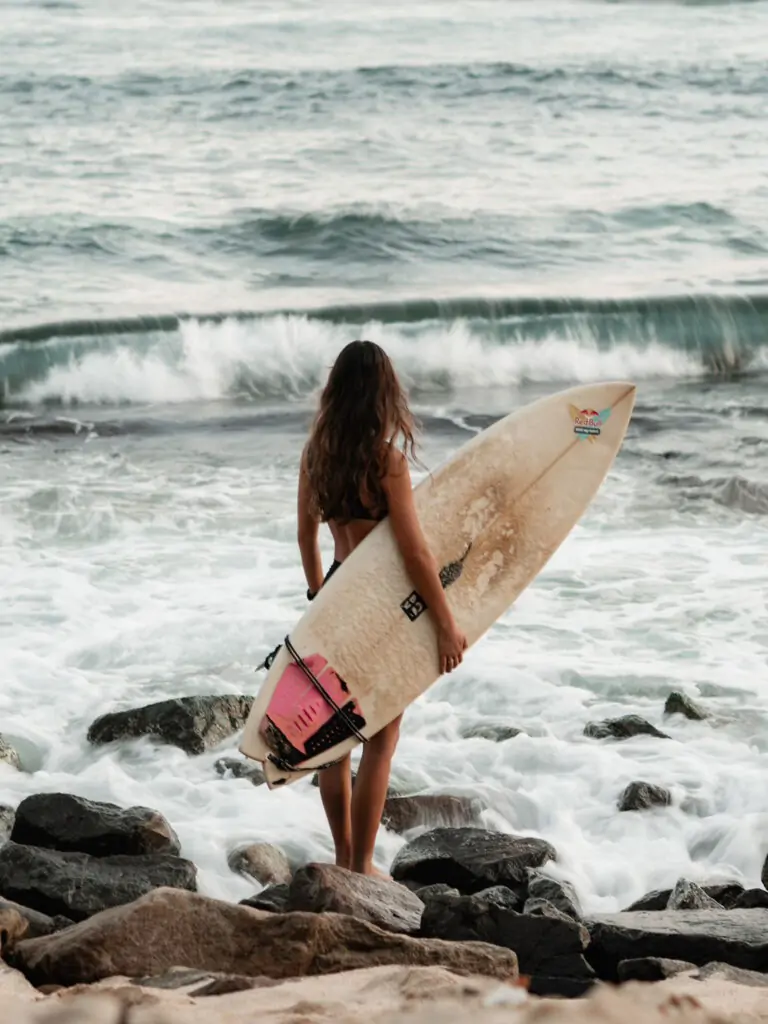
Arugam Bay, on Sri Lanka’s southeast coast, is a world-renowned surfing hotspot that truly delivers an exceptional experience for surfers of all skill levels. With its consistent point-break waves rolling in from the right, it’s considered a regional classic, offering thrilling rides on a sandy bottom interspersed with occasional rocks.
Main Point: The Heart of Arugam Bay Surfing
As its name suggests, Main Point is the undeniable epicenter of the East Coast surf scene, located directly on Arugam Bay Beach. This is the most powerful break in the area, a long, right-hand point break serving up impressive 4-10ft waves and beautiful rides spanning 200-500 meters. When the swell is just right, you might even catch an occasional barrel. Even on smaller days, Main Point is the only break that consistently works, making it your go-to spot when the waves are shy elsewhere.
Baby Point: The Beginner’s Embrace
Baby Point offers consistent 50-meter rides, providing an ideal environment to practice those crucial first turns without the risk of heavy closeouts. However, due to its beginner-friendly nature, Baby Point can get quite busy, especially during peak surf season, with many surf schools utilizing the spot. The vibe is generally friendly, but if you’re seeking a quieter learning experience, venturing a little further out of town might be a good idea.
Peanut Farm: Accessible Waves with a Rustic Charm
Nestled on a stunning, expansive beach adorned with sea vines and scattered boulders, Peanut Farm is a widely popular spot for accessible waves. From May to August, it buzzes with activity from surf schools, but don’t let the crowds deter you. Peanut Farm remains an excellent place to learn and truly enjoy the waves. This beach break features a sandy bottom, drawing its power from a low headland.
Whisky Point: The Ultimate Beginner’s Haven
Whisky Point is a true sanctuary for beginner surfers, celebrated for its incredibly gentle waves. This spot boasts soft and mellow right-handers that peel off a boulder point. While rare heavy ocean storms can occasionally generate swells up to 4 meters, such conditions are uncommon during Arugam Bay’s main surf season. Typically, the waves at Whisky Point range from chest-high to shoulder-high, giving novice surfers ample time to hone their skills. For maximum convenience, consider staying at the Whisky Point Resort, situated right in front of the break, allowing you to be the first to catch the morning sets – a fantastic addition to your surfing holiday.
Elephant Rock / Crocodile Rock
This prominent, jutting point break goes by two names: Elephant Rock and Crocodile Rock. While reaching the shore requires a roughly 20-minute walk with your surfboard, the effort is generously rewarded with uncrowded right-hand crumblers, especially when compared to the more popular spots in central Arugam Bay. Just a friendly heads-up: keep a keen eye out for crocodiles in the area!

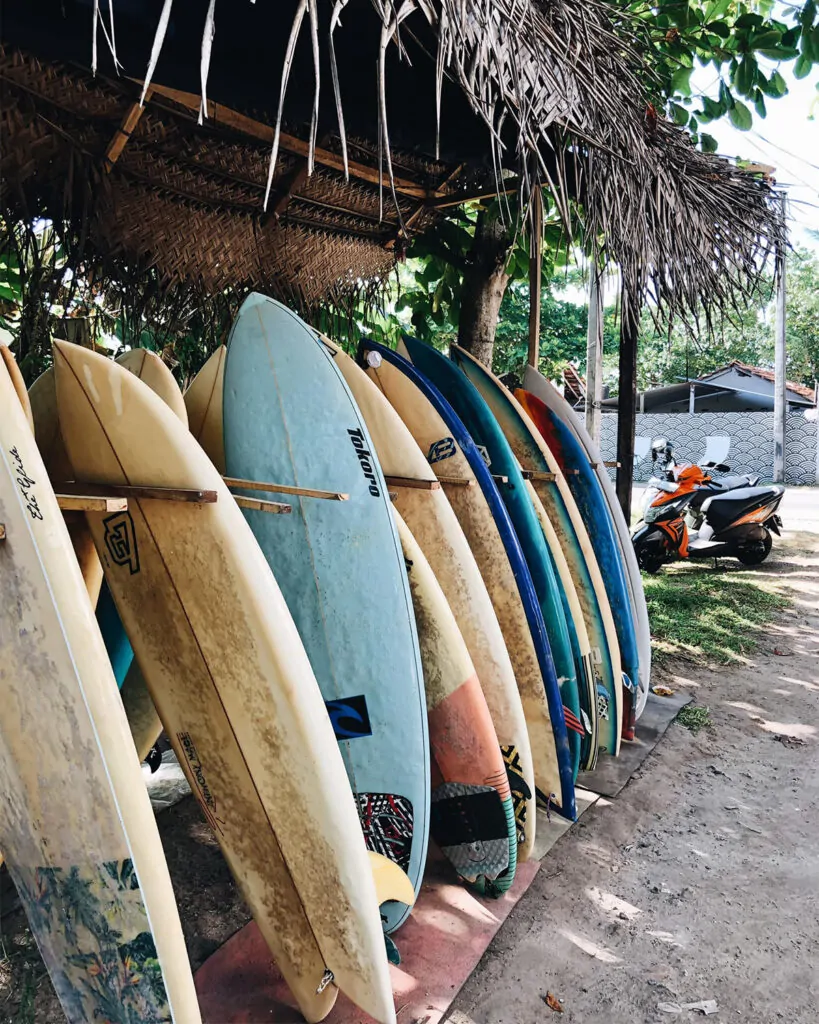
Arugam Bay truly offers a diverse range of surf breaks to suit every level of expertise. Which wave will you conquer first on your Sri Lankan surfing adventure? Contact Us for Travel Itineraries www.ceylonsilkroute.com
Arugam Bay, on Sri Lanka’s eastern coast, isn’t just a world-renowned surfing hotspot; it’s also a surprisingly vibrant hub for a deeply enriching yoga experience. The laid-back, bohemian atmosphere of the bay, coupled with the natural beauty of endless beaches and swaying palm trees, creates an ideal setting for those seeking to deepen their practice or simply find some inner peace.
Yoga in Arugam Bay often goes hand-in-hand with surfing, with many surf camps offering integrated “surf and yoga” packages. This combination is highly complementary: yoga helps surfers improve flexibility, balance, core strength, and mental focus, aiding in wave riding and recovery from intense sessions. Conversely, the invigorating feeling of being in the ocean can enhance the meditative state achieved through yoga.

Visitors can find a variety of yoga styles, including Vinyasa flow for dynamic movement, Hatha for foundational poses, and Yin yoga for deep stretching and relaxation, especially beneficial after a day of surfing. Classes are often held in open-air shalas with views of the ocean or surrounded by lush greenery, allowing practitioners to connect with nature’s calming energy. Morning sunrise sessions are particularly popular, offering a serene start to the day as the sun rises over the Indian Ocean. Sunset yoga sessions provide a beautiful way to wind down.
Beyond daily classes, Arugam Bay also hosts several dedicated yoga retreats and teacher training programs, attracting international instructors and students. These offer more immersive experiences, often including healthy, locally sourced meals, meditation, and opportunities to explore the surrounding area, such as nearby lagoons or national parks. The peak season for Arugam Bay, generally from May to October, offers the best weather for both surfing and outdoor yoga sessions, making it the perfect time to visit for this unique blend of activity and tranquility.
For the dedicated wildlife enthusiast or those enjoying an extended stay in Arugam Bay, a visit to Kumana National Park is an absolute must. This remarkable park is actually connected to the famous Yala National Park and was once part of the same vast protected area. A safari in Kumana offers incredible opportunities to spot an abundance of wildlife, including majestic buffalo, elephants, crocodiles, wild boar, and a spectacular array of birds. If luck is on your side, you might even catch a glimpse of a sloth bear or the incredibly elusive leopard.
What sets Kumana National Park apart from its more famous counterpart, Yala, is the blissful absence of crowds, making it one of the quietest national parks in Sri Lanka. Located just 35km south of Arugam Bay, it’s a mere 45-minute drive, perfect for a half-day trip in either the morning or evening. You can easily arrange a private jeep pickup from your hotel, returning you directly afterward, for around $100 for two people, making it an incredibly affordable and accessible wildlife safari experience.
We highly recommend the sunrise safari – witnessing the animals in their early morning routines was truly magical. A particular highlight was a playful group of cheeky orange monkeys chasing a grizzled giant squirrel, which we affectionately dubbed a “real-life Pokémon”!


For a quick and rewarding adventure, take the easy 5-minute climb to the top of Elephant Rock. This natural lookout point offers an awesome panoramic view of the surrounding Arugam Bay coastline. Directly below the rock is a popular surf spot, providing a fantastic aerial vantage point to watch surfers skillfully riding waves all the way into the beach.
Important wildlife tip: The area around Elephant Rock is known to be quite active with crocodiles and elephants in the evenings, so always keep a vigilant eye out for these magnificent creatures. We personally witnessed three elephants within a kilometer of Elephant Rock, confirming the accuracy of these warnings!
Just a few hundred meters south of the famous Arugam Bay surf breaks lies the slightly more elusive Crocodile Rock. While its world-renowned neighbor is celebrated for its amazing surf, Crocodile Rock also offers a fantastic surf escape in a more secluded setting.
The rocky outcrop of Crocodile Rock truly offers visitors the best of both worlds – just the right amount of wilderness combined with perfect waves. As you venture into the jungle fringes, keep your eyes peeled for glimpses of Sri Lanka’s beautiful fauna. And of course, as the name suggests, this includes crocodiles, so always watch out for any warning signs in the area!
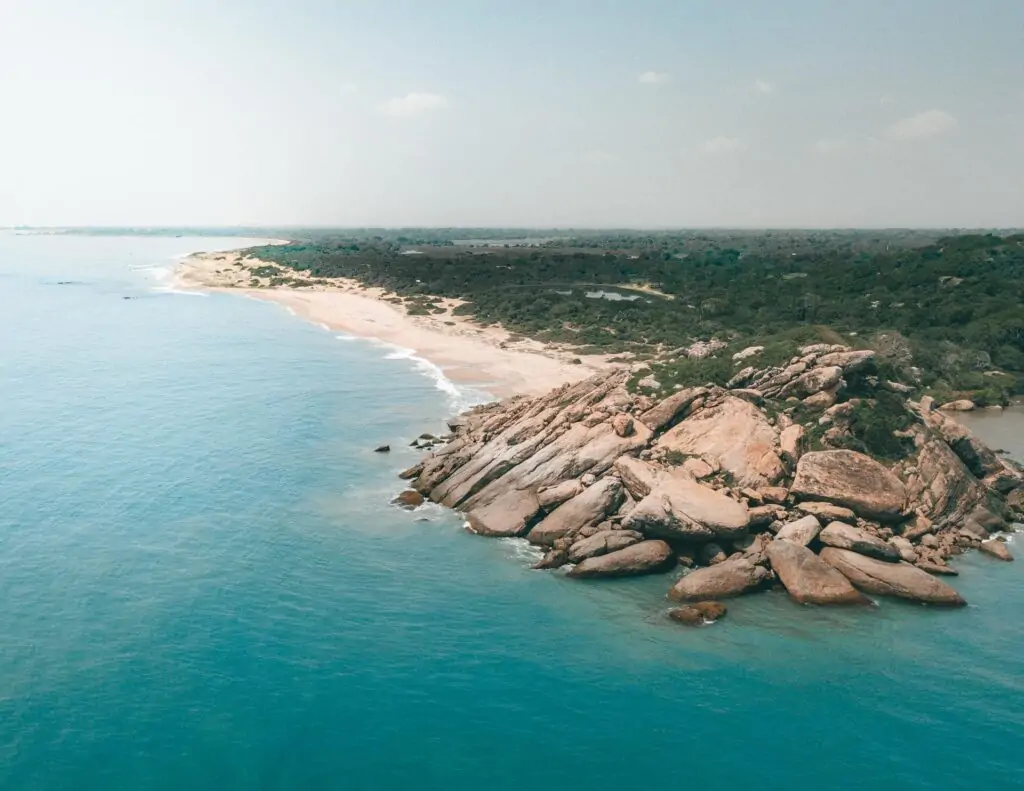
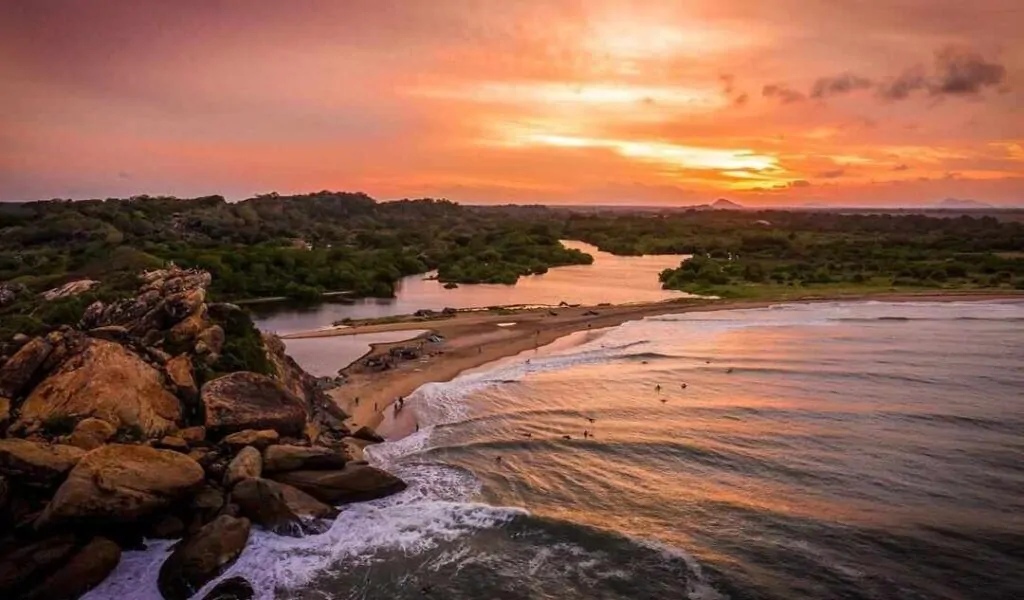
About a 25-minute drive from Arugam Bay, Whisky Point is another renowned surf spot, but it’s also a fantastic place to hang out even if you’re not planning to surf. During our visit in the shoulder season, there were no surf rentals available directly at Whisky Point, so if you plan to surf here outside of peak season, you’ll need to rent a board in Arugam Bay beforehand. Many of the local surf shops can also help arrange a tuk-tuk ride out here if you don’t have your own scooter. The long stretch of sand at Whisky Point is usually wonderfully quiet, making it the perfect spot for a chilled and relaxing afternoon at the beach.
As the sun dips below the horizon, Arugam Bay truly comes alive, keeping the energy going all the way to sunrise. Numerous bars in the area host vibrant beach parties where you can dance the night away. Mambo’s is a legendary spot, especially on Saturdays, with parties that often continue until the next day (we confess, we never made it that far, but it was incredibly fun to let loose for a few hours!). These parties generally operate on a weekly schedule, with various bars featuring DJs throughout the week.

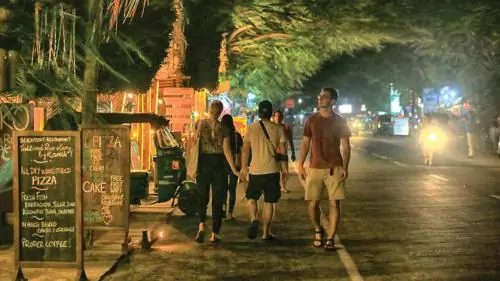
Arugam Bay’s dining scene is as diverse as its landscapes, offering a wide array of culinary delights to satisfy every palate. From authentic Sri Lankan staples to popular international cuisines, you’ll find something delicious around every corner.
Sri Lankan Cuisine Highlights: Rice and Curry: The quintessential Sri Lankan dish, featuring fragrant steamed rice served with an assortment of flavorful curries, including fish, meat, and a variety of vegetables.
Kottu Roti: A beloved Sri Lankan street food, this energetic dish is made from finely shredded roti bread, stir-fried with vegetables, spices, and your choice of meat or egg.
Lamprais: A traditional Sri Lankan delicacy consisting of rice, meat (often a rich curry), and vegetables, all meticulously wrapped in a banana leaf and steamed to perfection.
Hoppers: A unique and delicious Sri Lankan breakfast or snack, these thin, crispy pancakes are made from fermented rice flour and coconut milk, often served with a soft-fried egg in the center.
Curries: Beyond the comprehensive rice and curry, explore individual curries like the tangy Fish Ambul Thiyal (sour fish curry), aromatic chicken curry, creamy dhal (lentil) curry, and more.
Other Popular Dishes: Fresh Seafood: Given its coastal location, Arugam Bay is renowned for its incredibly fresh seafood. Many restaurants offer succulent grilled fish, flavorful crab curries, and generous seafood platters.
International Cuisine: For those craving familiar tastes, various restaurants in Arugam Bay also serve up popular international dishes like pizza, burgers, and other Western favorites.
The prime window for surfing in Arugam Bay falls between April and October, coinciding with Sri Lanka’s dry season. During these months, the Southwest monsoon brings consistent and strong swells to the East Coast of Sri Lanka. You can expect excellent offshore winds and generally good weather, creating perfect conditions for riding the waves.
Off-Season: November to March
From November to March, Arugam Bay enters its off-season. During this period, the sands shift south, onshore winds become prevalent, and the waves become less predictable. Most of the popular surf spots in Arugam Bay will not be working consistently, and the town itself becomes a “ghost town” with many businesses closed.
If your travel plans are set for these months and surfing in Sri Lanka is still your priority, it’s best to shift your focus to the South Coast of the island. Many vibrant surf towns along the South Coast offer excellent waves during Sri Lanka’s off-season for Arugam Bay.
Choosing the right time to visit Arugam Bay ensures you get the most out of your Sri Lanka surf holiday. Whether you’re chasing epic barrels or looking for a more relaxed learning experience, there’s a season that’s perfect for you!
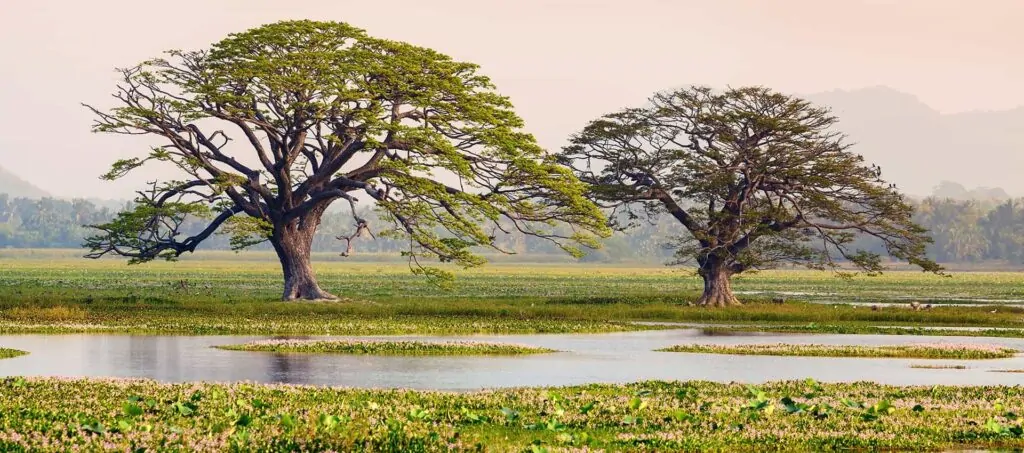
Kataragama is one of Sri Lanka’s most significant and revered pilgrimage towns, a unique melting pot of faiths where Buddhists, Hindus, Muslims, and even the indigenous Vedda people come together to worship. At its heart lies the Kataragama Devalaya, a temple complex dedicated to God Kataragama (known as Skanda or Murugan by Hindus), a deity associated with war, victory, and wisdom.
Unlike many temples, the main shrine doesn’t house an idol but a mystic chest, believed to hold the deity’s power. Daily rituals and offerings draw devotees seeking blessings and fulfillment of vows. The complex also includes the ancient Buddhist stupa Kiri Vehera, a mosque, and other shrines, all coexisting harmoniously.
Kataragama is particularly vibrant during its annual Esala Perahera festival (typically July/August), when hundreds of thousands of pilgrims gather for colorful processions, traditional dances, drumming, elephant parades, and even fire-walking ceremonies. The sacred Manik Ganga (River of Gems) flowing nearby is believed to have purifying and healing properties, with pilgrims taking ritual baths. This spiritual hub, surrounded by lush jungle and close to Yala National Park, offers a profound glimpse into Sri Lanka’s rich multicultural heritage and enduring devotion.
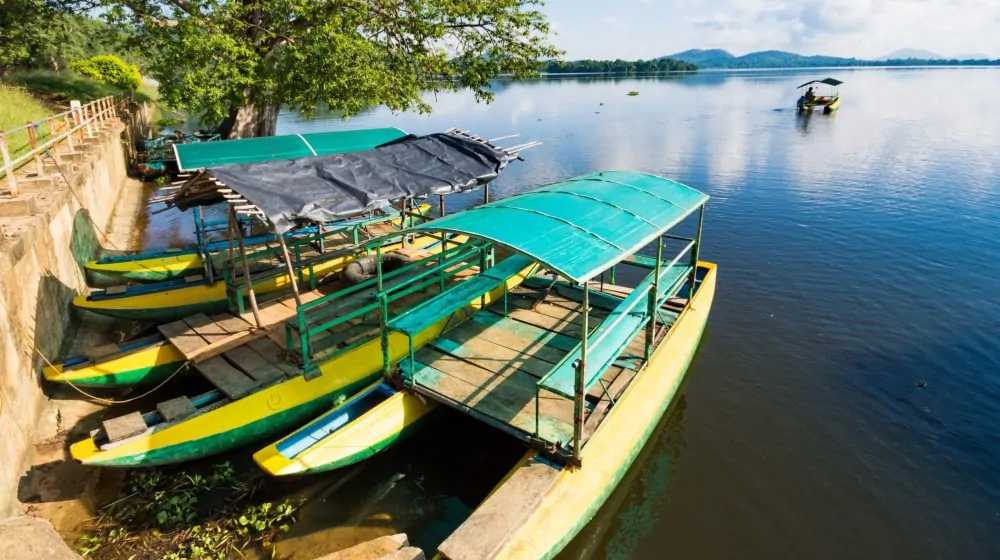

Mahiyanganaya, a town in Sri Lanka’s Badulla district, is a place of profound historical and cultural significance, especially for Buddhists. It’s believed to be the site of Lord Buddha’s first visit to the island, where he quelled a dispute between warring tribes and bestowed a lock of his hair, which is now enshrined in the revered Mahiyangana Raja Maha Viharaya (Stupa). This ancient stupa is a major pilgrimage site and a testament to early Sinhalese Buddhist heritage.
Beyond its religious importance, Mahiyanganaya is nestled amidst lush landscapes and offers a glimpse into Sri Lanka’s indigenous roots. It’s home to a community of Vedda people, the island’s aboriginal inhabitants, offering a unique opportunity to learn about their ancient customs and way of life. The region also features the impressive Sorabora Wewa, an ancient man-made reservoir showcasing remarkable early engineering. With its rich blend of history, spirituality, and cultural authenticity, Mahiyanganaya provides a tranquil and insightful experience for visitors.
Pasikuda, located on Sri Lanka’s eastern coast, is a burgeoning beach destination renowned for its extraordinarily shallow and calm waters, making it an ideal spot for swimming and families with young children. Its horseshoe-shaped bay boasts soft golden sands and crystal-clear turquoise waters, perfect for sunbathing and leisurely strolls.
Beyond relaxation, Pasikuda offers a range of water sports, including snorkeling, diving, windsurfing, and jet skiing, with vibrant coral reefs teeming with marine life just offshore. The area is relatively untouched compared to some of the more established southern beaches, offering a serene and tranquil escape. Nearby attractions include the more secluded Kalkudah Beach, the historically rich city of Batticaloa with its lagoon and Dutch Fort, and cultural sites like Hindu temples. The peak season for Pasikuda generally runs from May to September, offering excellent weather for beach activities.
WhatsApp us